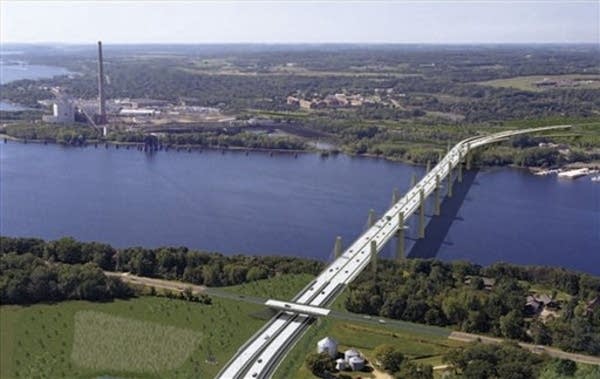Bachmann introduces new St. Croix bridge plan that would bypass federal environmental restrictions

U.S. Rep. Michele Bachmann, R-Minn., re-introduced a proposal Tuesday for a new St. Croix River bridge near Stillwater.
The bill would reverse last year's decision by the National Park Service that the project doesn't meet wild and scenic river rules and regulations.
Bachmann's bill says, in part, that construction of a four-lane bridge be, "deemed consistent with the Wild and Scenic Rivers Act."
Bachmann said a proposal by critics for a smaller span is just their latest delaying tactic. She said the critics don't want any bridge at all.
Create a More Connected Minnesota
MPR News is your trusted resource for the news you need. With your support, MPR News brings accessible, courageous journalism and authentic conversation to everyone - free of paywalls and barriers. Your gift makes a difference.
"Frankly the taxpayers that live on both sides of the river are tired of these antics. They want a to see a bridge built," she said. "We have a very old, old bridge that has been repaired, some people say it's held together with baler twine, and we have to get a bridge built. One day we'll wake up and the Stillwater bridge will not be functional."
The Minnesota Department of Transportation estimates the bridge cost at about $640 million. Planners say the actual span is about half that cost, and the rest is land acquisition and six miles of road improvements on either side of the Minnesota and Wisconsin border.
Rep. Betty McCollum, a Democrat, opposes the Bachmann bill and calls it a distraction.
McCollum said offers by bridge critics for a compromise are genuine.
"The Stillwater lift bridge is no longer adequate and a new bridge is needed," she said. "But I support a project that is appropriately scaled and designed to help relieve traffic congestion. Minnesota and Wisconsin officials should work together to create a new bridge project."
Everyone agrees the 80-year old Stillwater lift bridge is at or near the end of its useful life.
"It seems to me there's a way to have a bridge and a wild and scenic river, too. That's the challenge," said Denny Caneff, executive director of the Madison, Wis.-based River Alliance of Wisconsin.
Caneff said his statewide nonprofit is in the business of saving rivers.
Caneff said having a federally designated and protected wild and scenic river next to a major metropolitan area is very rare, and should be treated carefully. He doubts a four-lane freeway style bridge fits with that status.
"It's not a really wild river clearly, but it's a unique natural area that should be treated carefully, thoughtfully," said Caneff.
Critics of a new St. Croix River crossing say instead of a four-lane, 65 miles-an-hour span, the engineers should return to the drawing board and create a smaller, less disruptive bridge.
Jim Rickard, a spokesman for the Sierra Club's North Star chapter, said original traffic projections used to help justify a big bridge were too optimistic, and have not been substantiated.
"So our argument is, let's go back and revisit some of those traffic projections and really see do we need something for what was projected because the actual demand is not keeping pace with that," said Rickard.
However, supporters of a four-lane bridge say a smaller structure would be unwise.
John Soderberg, a banker in New Richmond, Wisconsin, has for years helped lead a coalition of businesses, landowners and commuters who want the new bridge.
Soderberg said this is not just about relieving congestion in downtown Stillwater caused by the old, two-lane lift bridge there.
"This should be looked at as a regional problem ... to carry these people who have jobs in Minnesota and vice versa, people in Minnesota who have jobs in Wisconsin," said Soderberg. "A four-lane bridge is the only practical thing to do."
The bridge issue was declared nearly dead late last year.
The Interior Department's National Park Service, responding to a lawsuit and a federal judge's order, reversed itself from a 2005 ruling giving the proposal a green light.
Now the Park Service says the four-lane span is too disruptive, and attempts to mitigate the effects to comply with wild and scenic river regulations fall short.
The Minnesota Department of Transportation put the project on a back burner. It was moved to a front burner by Gov. Mark Dayton last week.
"At this point, all possibilities have been reopened for consideration," he said.
